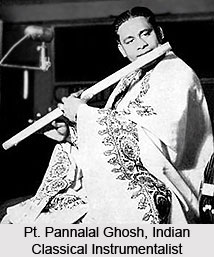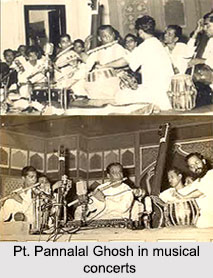 Pt. Pannalal Ghosh was a renowned Indian classical instrumentalist of the Indian "bansuri" (flute) and musician. A disciple of Bengali multi-instrumentalist Allauddin Khan, Pannalal Ghosh is credited with popularising the flute as a concert instrument in Hindustani classical music.
Pt. Pannalal Ghosh was a renowned Indian classical instrumentalist of the Indian "bansuri" (flute) and musician. A disciple of Bengali multi-instrumentalist Allauddin Khan, Pannalal Ghosh is credited with popularising the flute as a concert instrument in Hindustani classical music.
Early Life of Pannalal Ghosh
Pannalal Ghosh was born on July 24, 1911 into a humble family with musical inclinations in the Barisal city of erstwhile East Bengal, present day Bangladesh. He was named Amal Jyoti Ghosh, while Pannalal was his nickname. His father, Akshay Kumar Ghosh, was a sitarist and his brother Nikhil Ghosh later became a well-known tabla player. Many of his relatives pursued music seriously and thus his own inclinations moved along the same path from an early age. He began to learn the sitar under his father and vocal music under his uncle. Alongside music, his father was also a votary of physical culture and encouraged Pannalal to take up a vigorous programme in physical fitness. Pannalal also took to boxing and oriental martial arts and even a won a state-level prize in wrestling in his youth. In order to discipline his mind to musical training, the strong-willed young man would sit in motionless Padmasana position every day, until he could do so for long stretches of time. His practice sessions soon began to bear fruit, following the achievement of physical and mental discipline.
Pannalal moved to Kolkata in search of job soon after he turned 16. In his teens, like most fervent young men of the time, Pannalal got involved in the freedom movement. Due to his agility in physical culture, wrestling and martial arts, he found employment in an athletic club. He later worked with a tube well company. He was soon posted among the Santhal tribe. The rugged and vigorous Santhals were very much taken in by the young man`s physical prowess and strength. They played their folk tunes on the flute. Soon they began to tutor one another, with Pannalal picking up their folk tunes and in turn, teaching them physical exercises and martial arts. During this phase, he sealed his bond with the flute.
His father`s unexpected demise when he was 18 compelled him to return to Kolkata and seek productive employment, in the early 1930s. It was the era of silent cinema and instrumentalists were often hired to play music in cinema theatres. He trained in flute intensively during these years under a gifted harmonium player Khushi Mohammed and later under Girija Shankar Chakravarthy who further honed his skills. He chanced to meet the reputed music director Anil Biswas, who hired him to be part of his musical productions. Pannalal later married his sister, Parul Biswas, who later made a name for herself as a playback singer during the Talkies era. He also received opportunities to work for productions of music directors like Rai Chand Boral and S. D. Burman during the late 1930s. His association with such proficient directors not only improved his musical range, but also helped the music composer in him to evolve.
Contribution of Pannalal Ghosh in Music
 In a demanding production where Anil Biswas was adapting one of the great Bengali poet Kazi Nazrul Islam`s works for stage, Pannalal realised the tonal limitations of the flute he possessed. He searched throughout the city for the ideal flute that would give him the right pitch and sonority. He experimented with several of them from various stores, up till concluding that the bamboo flute was the ideal one. The only difference was that he managed to fabricate a flute that was nearly 32 inches long - a feat unheard of in the musical world and difficult to believe that such a long and sturdy reed could produce the delicate shades of classical music. But Pannalal proved that the long reed could indeed take on both classical and light strains at the same time. Given that it required immense adroitness to manipulate the blowholes, it was relentless practice and experimentation that helped him evolve the ideal technique for handling the instrument. His immense physical agility helped in large measure to tackle the crude and formidable instrument. The flute he used had 6 blow holes. He added an extra blow hole to help him take certain notes in the lower octave. Soon, he started to use a 2.5 feet long flute, which had a pleasing bass sonority. But he realized that he needed a different kind of flute to perform the raaga in lower octave. He came up with a large bamboo flute with 4 holes, which was ideal for playing sections of the Alap as also the Ati-vilambit Laya.
In a demanding production where Anil Biswas was adapting one of the great Bengali poet Kazi Nazrul Islam`s works for stage, Pannalal realised the tonal limitations of the flute he possessed. He searched throughout the city for the ideal flute that would give him the right pitch and sonority. He experimented with several of them from various stores, up till concluding that the bamboo flute was the ideal one. The only difference was that he managed to fabricate a flute that was nearly 32 inches long - a feat unheard of in the musical world and difficult to believe that such a long and sturdy reed could produce the delicate shades of classical music. But Pannalal proved that the long reed could indeed take on both classical and light strains at the same time. Given that it required immense adroitness to manipulate the blowholes, it was relentless practice and experimentation that helped him evolve the ideal technique for handling the instrument. His immense physical agility helped in large measure to tackle the crude and formidable instrument. The flute he used had 6 blow holes. He added an extra blow hole to help him take certain notes in the lower octave. Soon, he started to use a 2.5 feet long flute, which had a pleasing bass sonority. But he realized that he needed a different kind of flute to perform the raaga in lower octave. He came up with a large bamboo flute with 4 holes, which was ideal for playing sections of the Alap as also the Ati-vilambit Laya.
Hence with time, Pannalal devised ways to overcome several of the flute`s limitations. He showed the world that the flute could traverse the 3 octaves with ease. His genius soon came to the notice of music lovers in Calcutta who invited him to perform at musical conferences. The listeners were amazed by Pannalal`s brilliant raaga-daari and by the fact that bamboo flute could pull off the refinements of classical music. His close interactions with maestros Dabir Khan, Ustad Inayat Khan and Pt. Tarapada Chakravarthy helped him improve his technique and range. In 1940, Pannalal moved to Bombay upon request of several music directors who were desirous of making his flute a part of their orchestra. He worked with Bombay Talkies studio and composed the music for successful films like "Basant", "Police", "Sawaal" and "Aandolan".
Despite the success he tasted in tinsel town, he sensed a tormenting lack within himself. He realised his art would either blur or worsen in such an environment and he decided to give up music direction and devote himself wholly to pursuit of aesthetic perfection. Though largely self-taught, Pannalal felt that his art required the hand of grace that would elevate it. When Baba Allauddin Khan visited Bombay in 1947 along with Ravi Shankar, Pannalal expressed his desire to perfect his art under the great teacher. Baba, who had heard his music, told him that he required no further training; but the stubborn Pannalal persisted until Baba, convinced of his sincerity, accepted him as his disciple. Pannalal moved to Delhi and took up a position in All India Radio in order to facilitate his travel to Maihar. Though he learnt under Baba for less than a year, the inner artistic transformation that took place was momentous. Under Baba`s rigorous tutelage, Pannalal not only mastered the finer aspects of raaga and tala in Carnatic music, but also acquired the rare aesthetic depth.
While at All India Radio in Delhi, Pannalal performed a number of public recitals, which helped him popularize the flute in North India. He carried 3 flutes of varying sizes during these performances, each serving a different purpose. The biggest of them was used to play the raga in lower octave; the medium sized one for middle octave and the smallest for the highest octave. During recitals, he would effortlessly switch from the lower to the middle octave flute and sometimes back. His music obtained its seamless flowing facet from several aspects of Dhrupad and Khayal he incorporated into his style.
Pannalal Ghosh`s untimely demise in 1960, at the age of 49, came as a huge shock to the world of music. His disciple and son-in-law Devendra Murudeshwar continued his legacy with great devotion. His other gifted disciples include the senior most flautist of India Pt. V. G. Karnad and maestros like Haripad Choudhari, Aminur Rehman, Fakirchand Samanta, Gaur Goswami, Shreeram Joshi, Mahesh Mastfakir, Niranjan Haldipur, Bhailal Barot, Prabhakar Nachane, K. D. Desai, Mohan Nadkarni, Rashbihari Desai, Hari K. Chabria, Suraj Narayan Purohit and Sharad Mohalay. Among the contemporary artists following the Pannalal Ghosh Tradition fall Naresh Kumta, Harishchandra Kokare, Keshav Ginde, Nityanand Haldipur, Azizul Islam, Vijay Kabinittal, Lyon Leifer and David Philipson of the US, Anand Murdeshwar, Ravindra Samant, Harshawardhan Kaulgi, Abdul Bari Siddiqui and Vishvas Kulkarni.
Related Articles:
Allauddin Khan
Indian classical instrumentalist




















